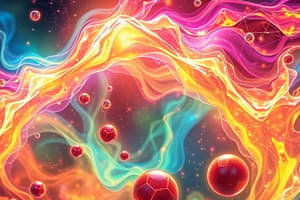Podcast
Questions and Answers
ଆମେ ଯୁକ୍ତ ହେବୁ ଏଥରିକ ସାର ______ ଦ୍ବାରା
ଆମେ ଯୁକ୍ତ ହେବୁ ଏଥରିକ ସାର ______ ଦ୍ବାରା
ଗୋଲକ
ଅମ୍ଲ, ଓକ୍ସଇଡ, ସଲ୍ଫେଟ, ଓ ହାଇଡ୍ରେଟସ୍ ଏହାର ମଧ୍ୟ ______ ଅଛନ୍ତି
ଅମ୍ଲ, ଓକ୍ସଇଡ, ସଲ୍ଫେଟ, ଓ ହାଇଡ୍ରେଟସ୍ ଏହାର ମଧ୍ୟ ______ ଅଛନ୍ତି
ବିଭିନ୍ନ ପ୍ରକାର
ସେମ୍ଣ୍ଟୋକ୍ସିନ୍ଗୁଡ଼ା ମେଟାଲ୍ସ ______, ଆଲୁମିନିଅମ ମଧ୍ୟ
ସେମ୍ଣ୍ଟୋକ୍ସିନ୍ଗୁଡ଼ା ମେଟାଲ୍ସ ______, ଆଲୁମିନିଅମ ମଧ୍ୟ
ଗୋଲ୍ଡ, ଆଇରଣ, କପର
ଆମେ ଯୁକ୍ତ ହେବୁ ଏଥରିକ ସାର ______ ଦ୍ବାରା
ଆମେ ଯୁକ୍ତ ହେବୁ ଏଥରିକ ସାର ______ ଦ୍ବାରା
ଜୀବନବ୍ୟତ୍ୟାର ଅଧ୍ୟୟନ କରନ୍ତୁ, ଆମେ ଯେ ମାଟିରେ ଆଧାରିତ ହେବୁ ______
ଜୀବନବ୍ୟତ୍ୟାର ଅଧ୍ୟୟନ କରନ୍ତୁ, ଆମେ ଯେ ମାଟିରେ ଆଧାରିତ ହେବୁ ______
ଆମେ ଏକ ଯୌଗିକ ପରିପାଠନରେ ହେବୁ ଏହାର ବାସ୍ତବରେ ______
ଆମେ ଏକ ଯୌଗିକ ପରିପାଠନରେ ହେବୁ ଏହାର ବାସ୍ତବରେ ______
ଇନରଗାନିକ ରସାୟନିକ ମୂଳାଙ୍କ ପ୍ରଯୋଗକରିବାକୁ ପେଣ୍ଡାଙ୍କ, ସଲ୍ଟଙ୍କ କମ୍ପାଉଣ୍ଡଙ୍କ ମଧ୍ୟରେ ଇଲେକ୍ଟ୍ରୋଷ୍ଟେଟିକାଲି ପ୍ରଭାବିତ ହେଉଛି; ଯେତେବେଳେ ଖାଣ୍ଡାଙ୍କ, ପଜରାଙ୍କ, ହେଲ୍କ୍, ଲାଏମ୍ଷ୍ଟୋନଙ୍କ _____ ଆଇୟନ୍ସ ଇଲେକ୍ଟ୍ରୋଷ୍ଟେଟିକାଲିକ ପ୍ରଭାବିତ ହେଇ
ଇନରଗାନିକ ରସାୟନିକ ମୂଳାଙ୍କ ପ୍ରଯୋଗକରିବାକୁ ପେଣ୍ଡାଙ୍କ, ସଲ୍ଟଙ୍କ କମ୍ପାଉଣ୍ଡଙ୍କ ମଧ୍ୟରେ ଇଲେକ୍ଟ୍ରୋଷ୍ଟେଟିକାଲି ପ୍ରଭାବିତ ହେଉଛି; ଯେତେବେଳେ ଖାଣ୍ଡାଙ୍କ, ପଜରାଙ୍କ, ହେଲ୍କ୍, ଲାଏମ୍ଷ୍ଟୋନଙ୍କ _____ ଆଇୟନ୍ସ ଇଲେକ୍ଟ୍ରୋଷ୍ଟେଟିକାଲିକ ପ୍ରଭାବିତ ହେଇ
ଇନରଗାନିକ ରସାୟନିକ ରସାୟନିକ ମୂଳାଙ୍କ ପ୍ରଯୋଗକରିବାକୁ ପେଣ୍ଡାଙ୍କ, ସଲ୍ଟଙ୍କ କମ୍ପାଉଣ୍ଡଙ୍କ ମଧ୍ୟରେ _____ ଏବଂ କ୍ଲୋରାଇଡଙ୍କ ଆଇୟନ୍ସ ଇଲେକ୍ଟ୍ରୋଷ୍ଟେଟିକାଲିକ ପ୍ରଭାବିତ ହେଇ
ଇନରଗାନିକ ରସାୟନିକ ରସାୟନିକ ମୂଳାଙ୍କ ପ୍ରଯୋଗକରିବାକୁ ପେଣ୍ଡାଙ୍କ, ସଲ୍ଟଙ୍କ କମ୍ପାଉଣ୍ଡଙ୍କ ମଧ୍ୟରେ _____ ଏବଂ କ୍ଲୋରାଇଡଙ୍କ ଆଇୟନ୍ସ ଇଲେକ୍ଟ୍ରୋଷ୍ଟେଟିକାଲିକ ପ୍ରଭାବିତ ହେଇ
ଇନରଗାନିକ ରସାୟନିକ ମୂଳାଙ୍କ ପ୍ରଯୋଗକରିବାକୁ ପେଣ୍ଡାଙ୍କ, ସଲ୍ଟଙ୍କ କମ୍ପାଉଣ୍ଡଙ୍କ ମଧ୍ୟରେ ଇଲେକ୍ଟ୍ରୋଷ୍ଟେଟିକାଲି ପ୍ରଭାବିତ ହେଉଛି; ଯେତେବେଳେ ଲାଏମ୍ଷ୍ଟୋନଙ୍କ, କାଲ୍କିଅମ୍ ସଲ୍ଫେଟ୍ ଡାଇହାୟଡ୍ରେଟ୍, ଆଣ୍ଡ୍ ଲାଏମ୍ଷ୍ଟୋନଙ୍କ କାଲ୍କିୟମ୍ କାର୍ବୋନେଟ୍, _____ ଆଧାରରେ ଆଇଅନ୍ସ, ସଲ୍ଫେଟ୍ସ, ଆଣ୍ଡ୍ ହାଇଡ୍ରେଟ୍ସ ପ୍ରତିଭାବିତ ହେଉଛି
ଇନରଗାନିକ ରସାୟନିକ ମୂଳାଙ୍କ ପ୍ରଯୋଗକରିବାକୁ ପେଣ୍ଡାଙ୍କ, ସଲ୍ଟଙ୍କ କମ୍ପାଉଣ୍ଡଙ୍କ ମଧ୍ୟରେ ଇଲେକ୍ଟ୍ରୋଷ୍ଟେଟିକାଲି ପ୍ରଭାବିତ ହେଉଛି; ଯେତେବେଳେ ଲାଏମ୍ଷ୍ଟୋନଙ୍କ, କାଲ୍କିଅମ୍ ସଲ୍ଫେଟ୍ ଡାଇହାୟଡ୍ରେଟ୍, ଆଣ୍ଡ୍ ଲାଏମ୍ଷ୍ଟୋନଙ୍କ କାଲ୍କିୟମ୍ କାର୍ବୋନେଟ୍, _____ ଆଧାରରେ ଆଇଅନ୍ସ, ସଲ୍ଫେଟ୍ସ, ଆଣ୍ଡ୍ ହାଇଡ୍ରେଟ୍ସ ପ୍ରତିଭାବିତ ହେଉଛି
Flashcards are hidden until you start studying
Study Notes
Exploring Inorganic Chemistry's Fascinating World
Inorganic chemistry occupies one of two main branches within the expansive realm of chemical science—the other being organic chemistry. While its neighbor deals with carbon-based compounds, this field delves into everything else, encompassing elements from across the periodic table. Therein lies an incredibly vast and diverse array of molecules, materials, and phenomena worthy of exploration and discovery. Let us embark upon our journey through the world of inorganic chemistry together.
Elemental Fundamentals
Firstly, we will examine the building blocks of inorganic chemistry: elements themselves. These substances form simple yet essential structures when combined, providing fundamental insights into the properties, reactions, and applications of various materials. Some examples include metals like gold, iron, copper, and aluminum; nonmetals such as hydrogen, oxygen, nitrogen, phosphorus, and chlorine; and metalloids including silicon, germanium, tellurium, and selenium.
Formations and Compound Types
With these elements serve as starting points, the formation of numerous types of inorganic compounds commences. Salts, oxides, sulfates, and hydrates are some common forms found. For instance, sodium chloride (NaCl) is a salt compound where sodium and chloride ions interact electrostatically; while rust (iron oxide, Fe₂O₃), gypsum (calcium sulfate dihydrate, CaSO₄·2H₀₅O), and limestone (calcium carbonate, CaCO₃) represent oxides, sulfates, and hydrates respectively.
Bonding Mechanisms
The nature of bonding between atoms also plays a significant role in shaping the properties of inorganic compounds. Covalent bonds generally involve shared electrons among adjacent atoms, whereas ionic bonds arise due to transferring electrons, leading to positively charged cations and negatively charged anions. This distinction affects the reactivity and stability of different classes of inorganic compounds.
Crystal Structures and Solids
Understanding crystal structures further deepens appreciation of inorganic chemistry principles, particularly regarding solid state matter. Each atom has specific positions within repeating patterns called lattices, resulting in predictable spatial arrangements of particles within solids. By analyzing the dimensions and geometric relationships in crystallographic units, chemists can deduce crucial information about a substance’s physical properties.
Applications in Everyday Life and Industry
Beyond the Fundamentals, the practical implications of inorganic chemistry permeate nearly every aspect of daily life. Paint pigments, ceramics, catalysts, batteries, semiconductors, fertilizers, coatings, water treatment systems, solar panels, pharmaceuticals — all utilize fundamentals of inorganic chemistry. Without it, modern civilization would grind to a halt!
As you venture deeper into the intricate landscape of inorganic chemistry, remember that each concept builds upon those preceding it, forming a unified structure of understanding. Delve forthwith, and witness how much there is left to discover!
Studying That Suits You
Use AI to generate personalized quizzes and flashcards to suit your learning preferences.



